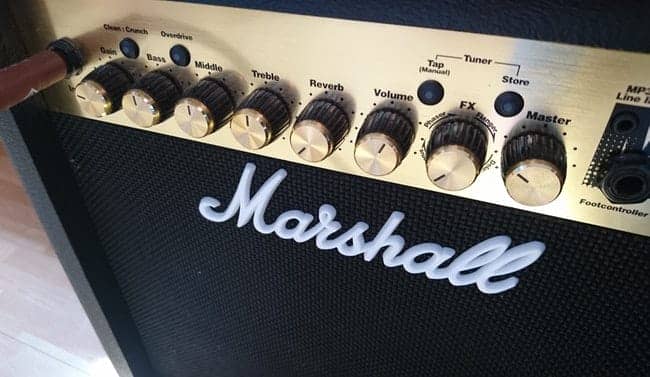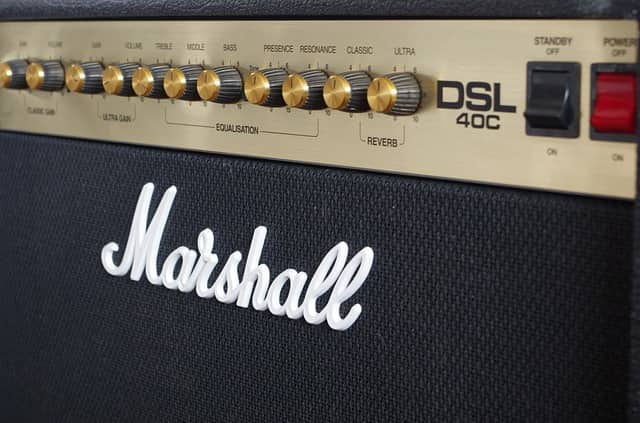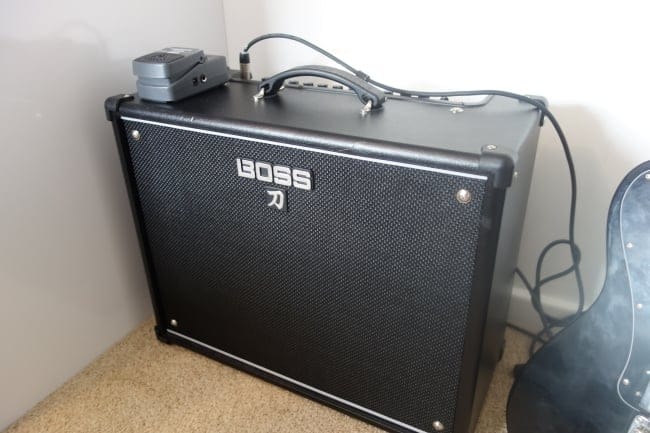
If you are like me, I am always on the hunt for great tones at bedroom volumes.
With my experience with solid-state amps, I will give you the low down on the topic of which amp is best for playing at low volumes and as a bonus, discuss my experience gigging with solid-state amplifiers.
So let’s answer the main question…
Do solid state amps sound good at low volume?
Solid state amps electronics, circuitry and wattage are designed to create a broader range of tones at lower volumes suited for home and bedroom practice. Solid states produce distortion, saturation at lower volumes as they do not use power tubes for amplification unlike valve amps.
Comparing Solid-State to Tube Amps
Solid state amps use a combination of diodes and transistors to produce their distortion and volume. Some solid-state amps use a mixture of both tube and solid state circuitry called ‘hybrids.’
whereas, full-blown tube amps adopt preamp and power tubes as the engine room for amplifying a guitar signal. both methods of amplification both their own individual pros and cons.
First, Let’s talk about the sound quality of solid state distortion and clean tones being the main staple of any guitar tone.
Solid-State Distortion
The usual notion about solid state distortion is that it is not as ‘organic’ and ‘natural’ sounding as the distortion from a valve amp, even at lower volumes.
The reason is solid state distortion is mostly produced digitally (depending on the amp) being the reason why it can sound ‘processed’ ‘fizzy’ and ‘unnatural’ compared to the ‘smoother’ and ‘natural’ sound of tube distortion.
The Pros of Being Digital
However, being digital does have its pros, as solid-states produce distortion at next to no volume. Hence why they are best suited for your
Whereas, a 20 watt tube amp needs a large amount of volume in order to saturate. The volume required for this to get some nice sounding distortion will have the neighbors complaining for sure.
As it will not be able to produce its true sound and frequencies unless they are on-stage for gigging volumes and not suited for bedroom use.
If you want that true Marshall style ‘lush’ and ‘tube’ crunchy tone, the downside is that most solid states and modeling amps struggle to replicate a true cranked tube tone which makes sense because of its electronics and solid-state design.
Keep in mind, these points I have made are all subjective as all guitar players tastes vary when it comes to tone.
Other players may actually like the sound and that is fine as with everything, it is all about personal preference at the end of the day when it comes to your ideal sound.
Solid-State Clean Tones
When it comes to the clean tones… solid-state clean is known for being ‘warm’ and not as clear as a tube amps clean.
This can be especially true when using a guitar with humbuckers, single coils would be the better option to remove bass from the tone.
However, depending on the amp some solid states can produce some decent clean tones. Jazz guitarists have become fond of solid state amps for their warmer tone ultimately creating a jazzier tone when playing live. Again this is all subjective.
Consistent Sound
Another point about solid states is compared to a medium watt tube amp, the sound is more consistent across a larger range of volume.
Whereas the volume on a tube amps need to be cranked to enough in order to push the tubes for ‘break-up’ and saturation for the sound of crunchy goodness.
Meaning solid states amps can easily create a range of tones (clean, crunch, overdrive, heavy distortion) at bedroom practice volumes for a range of versatile tones.
Their design and purpose are aimed at the bedroom guitar players, however, more solid states are being loaded with a crazy amount of wattage up to 100-watts for using live. I myself have done so myself!
Do Tube Amps Sound Good at Low Volume?

I can’t talk about solid states low volume credentials without discussing its opposite number… the valve amp!
Tube amp tone distortion is known for being ‘warmer’ ‘smoother’ and more ‘natural’ sounding than solid state amps.
The clean tones are also ‘defined’, ‘clearer’ and more ‘responsive’. I also notice when you dig into your strings with the pick you get more of a tonal response with tube amps.
Their great tone and volume potential is the reason why tube amps have long been the staple when it comes to the perfect gigging companion.
Tube Amps are Not Bedroom Friendly!
However, for playing at low volumes, a high wattage amp with power tubes will not be the best bedroom playing option.
For example, a 30-watt tube amp
The only tube amp you can use at for bedroom levels is either a 1 watt or a maximum of 5-watts.
Even a 5-watt valve amp needs a decent amount of volume in order to saturate for distortion which is louder than the usual home practice volumes. Keep in mind, even a cranked 5-watt amp can be loud as hell!
A tube amp with a built-in attenuator switch that can knock the wattage down to 1 watts as a maximum would be an ideal feature for getting a good sound and at bedroom volumes.
I must admit when it comes to tone I do prefer the sound of tube amps compared to solid state However, tube amps lack the versatility of solid states at the same price range when it comes to effects (delay, flanger, chorus, etc) EQ options and other features.
So when it comes to experimenting with tones, solid states are going to be the best option having more effects and EQ options but not having the pure analogue and responsive feel of a tube amp. Unless you have a ton of external pedals at your disposal.
Solid state amps sound best when the volume is tamed whereas, tube amps sound better when they are unleashed!
Do Solid State Amps Sound Good at Gigging Volumes?

With the advancement of solid-state technology I would have to admit, solid state amps are getting much more love these days when it comes to a worthy gigging amplifier.
The Tube/valve amp route has been the staple for years when it comes the
However, the usual criticism with digital/solid state amps is when it comes to gigging volumes, are they do not sound as good compared to their tube amp counterparts. The criticism usually comes with two main reasons…
The Negatives
The first being solid state distortion can sound overly ‘processed’ ‘digital’ ‘fizzy’ and a little harsh at gigging volumes compared to the usual ‘smoother’, ‘warmer’ and analog sounding tube distortion.
The second reason is that solid state clean tones at gigging volumes can sound ‘warm’ and ‘muddy’ basically nowhere near as much ‘clarity’ and ‘definition’ for them ‘pristine’ tones from a high watt tube amplifier.
Meaning if you desire some crystal clear clean tones solid-states are not the way to go. Obviously guitar and pickup choice will also play a factor here.
But obviously with everything in life you have to take the good with the bad. What you lack in sound and tone when gigging with solid states. You make up for it in a few key areas…
Why Solid-States are Value for Money
The first reason being price. These amps are a fraction of the cost of most tube amplifiers. Meaning more budget for pedals, guitars and I guess more important things in life….. like more guitars!
The second being versatility. Depending on the amp, some solid states are virtually built-in guitar effect processors in an amp! Tons of effects, EQ options, amp modeling technology, aux connection for phones and many more.
Also having an amp that can perform well at home, rehearsals and small gigs being a great bonus.
Another area to consider for the heavy gigging guitar players is portability. Carrying a lighter and more forgiving 2×12 combo is much more easier work than transporting a heavy and fragile tube amp. Which brings me to my last point….
The last key point being the differences in reliability. Tube/valve amps adopt power tubes as their main amplification source which are unfortunately housed in a fragile glass chassis which can easily break during transportation, and give out at anytime (especially during a gig).
My Experience with Solid State Live

With my person experience of using solid states amplifiers for gigs. Mainly with my 100 watt Boss Katana Combo (Image Above) which is a great little amplifier I must add.
The versatility in tones that comes with this amp is fantastic, easily storing my
The amp has
The Negatives
When it came to tone however, I will have to admit I was not 100% satisfied with the amps distortion.
For me I will have to agree with the general criticism of solid states being the
Even with a large effort when it came to EQ and dialing that smoother distortion I was after, it just was not possible with a digital amp.
However, this is my personal opinion of my amp and sometimes I must admit I can be a tone snob sometimes. For another guitar player, the distortion tone can sound perfectly fine even great as everyone have different tastes.
Another alternative is to skip the amps distortion altogether and use your favourite distortion or overdrive pedal. Problem solved! The closer solid state distortion can sound more like tube amps the better.
For gigging I will always be using a tube amp and for home practice at low volumes I will be using a solid state. Whatever you choose Is your personal choice!
Related Questions
Are all solid state amps digital?
Not all solid states are fully digital, some use a combination of solid state and valve technology such as ‘hybrid amps’ which offer a mixture of both sounds. The preamp in the unit is solid state whereas the power amp section is comprised of a vacuum tube.
Do solid state amps need to warm up before playing?
Solid state amps do not use power tubes for amplification therefore do not need to be left on standby in order to warm up unlike some tube amps. Power tubes will sound best when the filaments have warmed the inside of the glass housing for the best sound.
